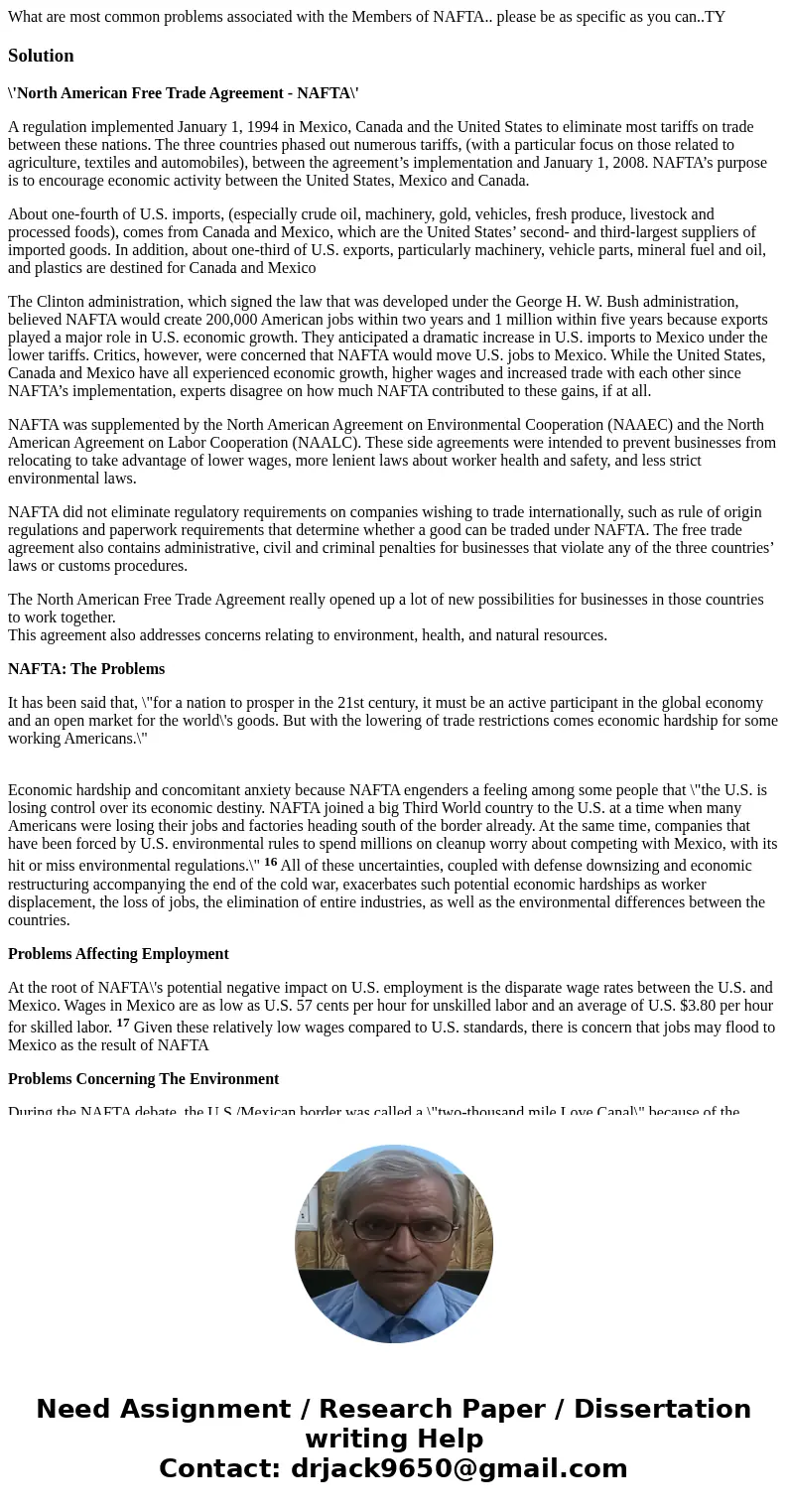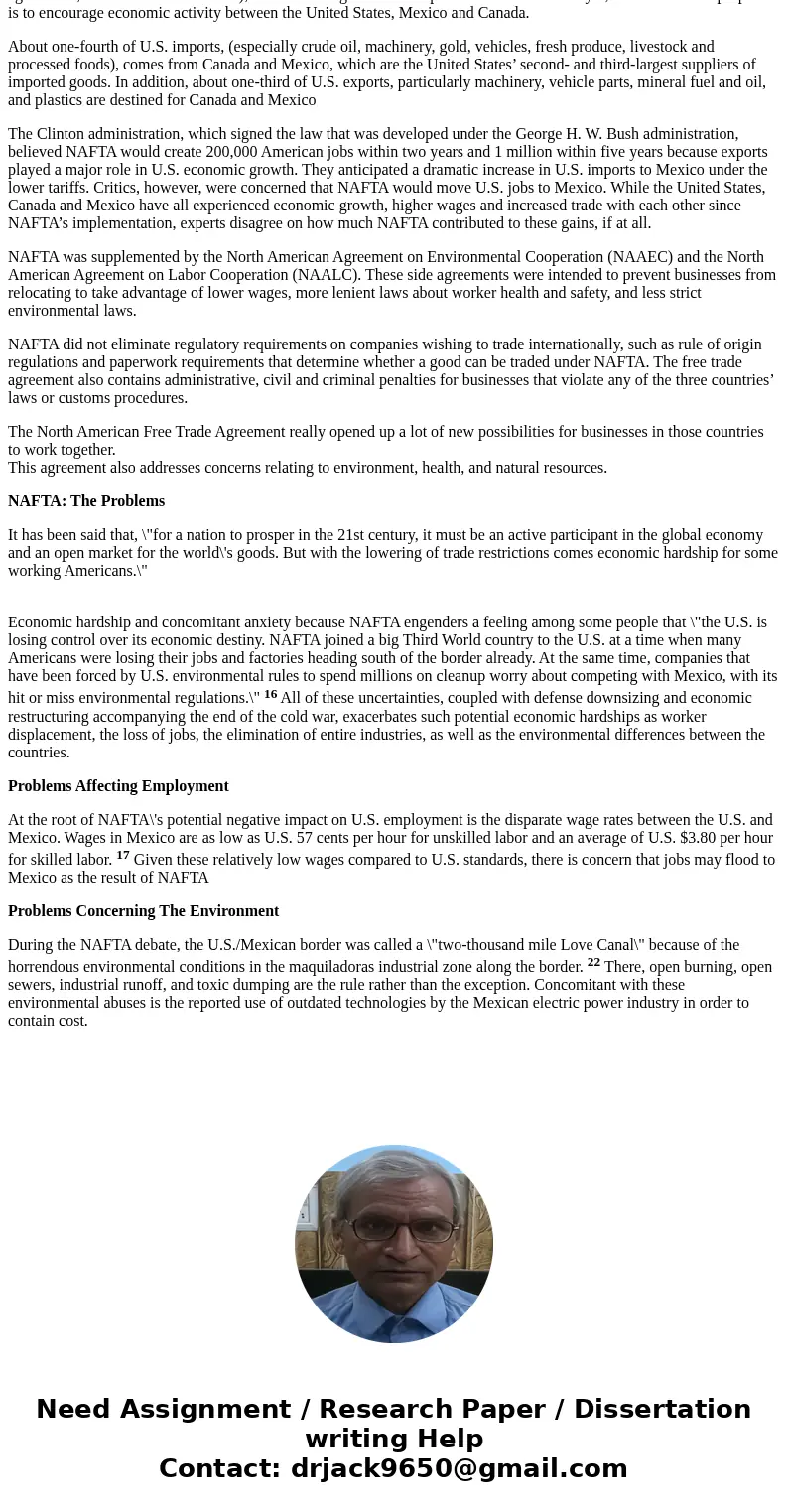What are most common problems associated with the Members of
What are most common problems associated with the Members of NAFTA.. please be as specific as you can..TY
Solution
\'North American Free Trade Agreement - NAFTA\'
A regulation implemented January 1, 1994 in Mexico, Canada and the United States to eliminate most tariffs on trade between these nations. The three countries phased out numerous tariffs, (with a particular focus on those related to agriculture, textiles and automobiles), between the agreement’s implementation and January 1, 2008. NAFTA’s purpose is to encourage economic activity between the United States, Mexico and Canada.
About one-fourth of U.S. imports, (especially crude oil, machinery, gold, vehicles, fresh produce, livestock and processed foods), comes from Canada and Mexico, which are the United States’ second- and third-largest suppliers of imported goods. In addition, about one-third of U.S. exports, particularly machinery, vehicle parts, mineral fuel and oil, and plastics are destined for Canada and Mexico
The Clinton administration, which signed the law that was developed under the George H. W. Bush administration, believed NAFTA would create 200,000 American jobs within two years and 1 million within five years because exports played a major role in U.S. economic growth. They anticipated a dramatic increase in U.S. imports to Mexico under the lower tariffs. Critics, however, were concerned that NAFTA would move U.S. jobs to Mexico. While the United States, Canada and Mexico have all experienced economic growth, higher wages and increased trade with each other since NAFTA’s implementation, experts disagree on how much NAFTA contributed to these gains, if at all.
NAFTA was supplemented by the North American Agreement on Environmental Cooperation (NAAEC) and the North American Agreement on Labor Cooperation (NAALC). These side agreements were intended to prevent businesses from relocating to take advantage of lower wages, more lenient laws about worker health and safety, and less strict environmental laws.
NAFTA did not eliminate regulatory requirements on companies wishing to trade internationally, such as rule of origin regulations and paperwork requirements that determine whether a good can be traded under NAFTA. The free trade agreement also contains administrative, civil and criminal penalties for businesses that violate any of the three countries’ laws or customs procedures.
The North American Free Trade Agreement really opened up a lot of new possibilities for businesses in those countries to work together.
This agreement also addresses concerns relating to environment, health, and natural resources.
NAFTA: The Problems
It has been said that, \"for a nation to prosper in the 21st century, it must be an active participant in the global economy and an open market for the world\'s goods. But with the lowering of trade restrictions comes economic hardship for some working Americans.\"
Economic hardship and concomitant anxiety because NAFTA engenders a feeling among some people that \"the U.S. is losing control over its economic destiny. NAFTA joined a big Third World country to the U.S. at a time when many Americans were losing their jobs and factories heading south of the border already. At the same time, companies that have been forced by U.S. environmental rules to spend millions on cleanup worry about competing with Mexico, with its hit or miss environmental regulations.\" 16 All of these uncertainties, coupled with defense downsizing and economic restructuring accompanying the end of the cold war, exacerbates such potential economic hardships as worker displacement, the loss of jobs, the elimination of entire industries, as well as the environmental differences between the countries.
Problems Affecting Employment
At the root of NAFTA\'s potential negative impact on U.S. employment is the disparate wage rates between the U.S. and Mexico. Wages in Mexico are as low as U.S. 57 cents per hour for unskilled labor and an average of U.S. $3.80 per hour for skilled labor. 17 Given these relatively low wages compared to U.S. standards, there is concern that jobs may flood to Mexico as the result of NAFTA
Problems Concerning The Environment
During the NAFTA debate, the U.S./Mexican border was called a \"two-thousand mile Love Canal\" because of the horrendous environmental conditions in the maquiladoras industrial zone along the border. 22 There, open burning, open sewers, industrial runoff, and toxic dumping are the rule rather than the exception. Concomitant with these environmental abuses is the reported use of outdated technologies by the Mexican electric power industry in order to contain cost.


 Homework Sourse
Homework Sourse